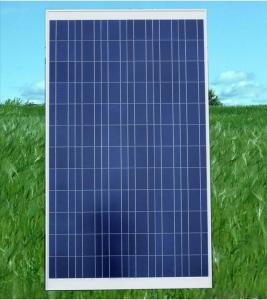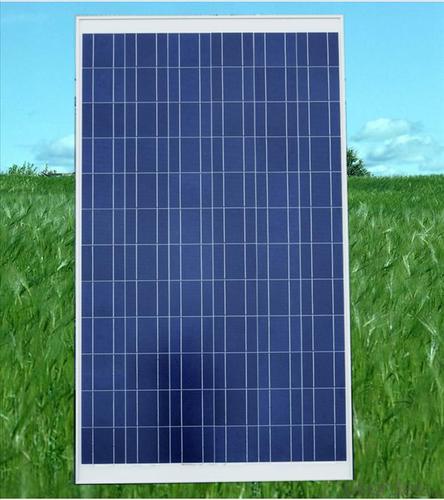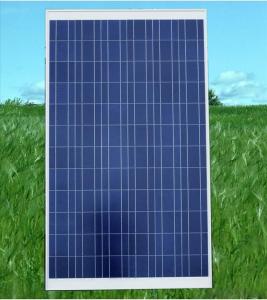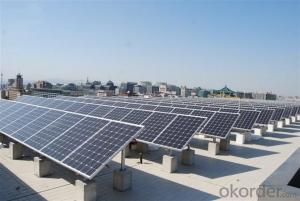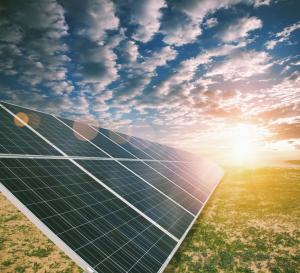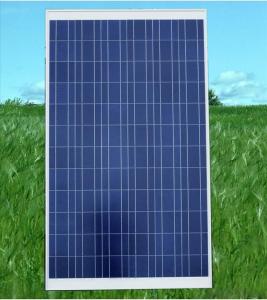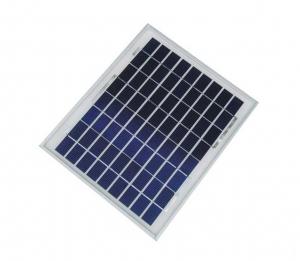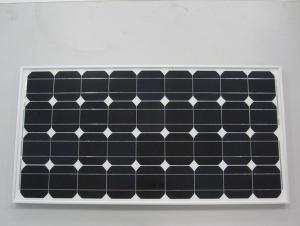Minnesota Solar Panels - Polycrystalline 265W Silicon Solar Panel
- Loading Port:
- Nanjing
- Payment Terms:
- TT OR LC
- Min Order Qty:
- 200000 watt
- Supply Capability:
- 20000000 watt/month
OKorder Service Pledge
OKorder Financial Service
You Might Also Like
INTRODUCTION
This installation Manual contains essential information for the electrical and mechanical installation that your must know before installing CUSTOMER PV modules. This also contains safety information you need to be familiar with .All the information described in this manual are the intellectual property of CNBM and based on the technologies and experiences that have been acquired and accumulated in the long history of CUSTOMER. This document does not constitute a warranty, expressed or implied.
CUSTOMER does not assume responsibility and expressly disclaims liability for loss, damage, or expense arising out of in anyway connected with installation, operation, use or maintenance of the PV modules. No responsibility is assumed by CUSTOMER for any infringement of patents or other rights of third parties that may result from use of PV module.
CUSTOMER reserves the right to make changes to the product, specifications or installation manual without prior notice.
WORK PRINCIPLE
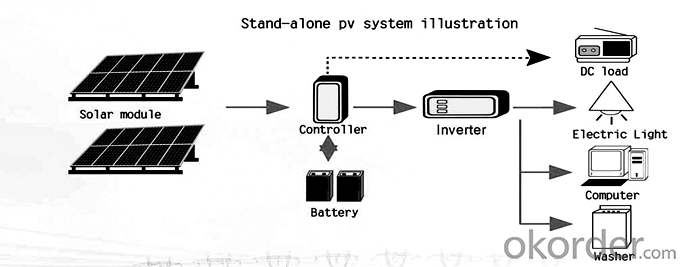
COMPONENTS
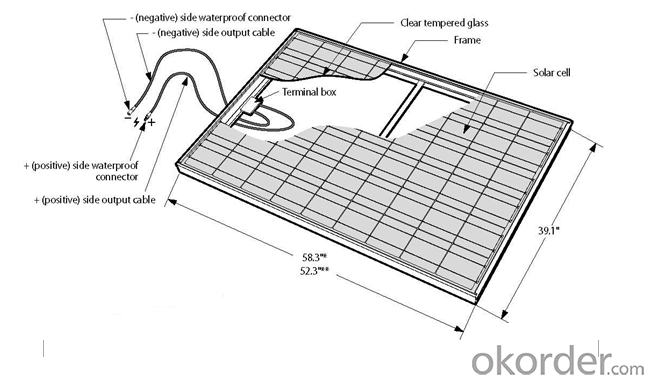
WIRING
To ensure proper system operation to maintain your warranty, observe the correct cable connection polarity(Figures 1&2) when connecting the modules to a battery or to other modules. If not connected correctly, the bypass diode could be destroyed.
PV modules can be wired in series to increase voltage. Connect wires from the positive terminal of one module to the negative of the next module. Figure shows modules connected in series .
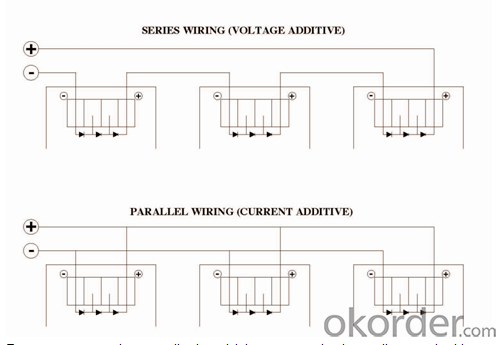
GROUDING
All PV models must be grounded by electrical connection of the module frames to ground. Please be careful in arranging the system ground so that the removal of one module from the circuit will not interrupt the grounding of any other modules.
The modules should be grounded to the same electrical point as described below.
Each PV module has a hole on the side frame of either a bolt, nut and washer grounding the module to the frame, a ground lug fastened by bolt or screw, or appropriate screw(hardware not provided).An example of acceptable ground connection using a bolt, nut and washer retaining a ground lug is shown in figure 3,in a connection of this type, the hardware(such as a toothed locked washer/star washer) must score the frame surface to make positive electrical contact with the frame. The ground wire must be considered within the requirement of local and regulation at the site of installation.
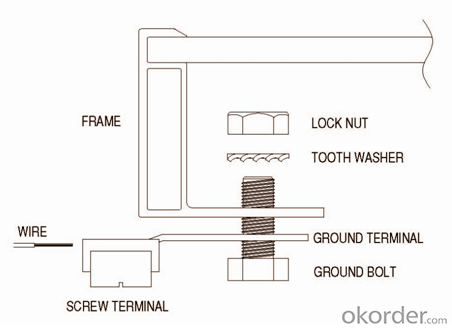
DATA SHEET
Maximum power | 265W |
Cell type(mm) | Polycrystalline solar cell 156*156 |
Number of cell(pcs) | 60(6*10) |
Manufacture site | China |
Open-circuit voltage(voc) | 37.7V |
Maximum power voltage(vmp) | 30.6V |
Short-circuit current(isc) | 9.03A |
Optimum operating current(imp) | 8.66A |
Power tolerance | 0~+5W |
Module efficiency | 16.3% |
Dimensions(mm) | 1640*992*40 |
Weight | 19 kg |
Backsheet | Silver |
Frame Colar | White |
Frame | Anodized Aluminum Alloy |
- Q: is this fact true? - its a limitation to solar panels during summer when it's in extremly hot countrie. I've heard it from my science teacher .. please give detail if you have any and any more benefits/limitations is welcomed .. Thank you :) !
- Solar okorder /... you'll notice that they have different curves for different temperatures. But they do still produce power, certainly. I have an array on my roof, and it still manages to max out the inverter on a hot summer day. But I do notice that the top row, which is hotter due to heat rising from those below, consistently puts out a few less watts than the bottom row. So more sun is certainly better; direct light is exactly what's needed. But hot panels due to poor air circulation or high ambient temperature does cut into efficiency. (Solar thermal, of course, is a different story)
- Q: What is the difference b/w them which one is better .
- In the practical sense, the differences are trivial. I'd buy on price per watt, unless space is at a premium (it isn't for most installations).
- Q: Can solar panels be used in areas with high humidity?
- Yes, solar panels can be used in areas with high humidity. However, high humidity can potentially reduce their overall efficiency due to increased moisture in the air, which may affect the performance of the panels. It is important to ensure proper maintenance and cleaning of the panels to prevent any buildup of dirt or moisture, which can further affect their performance in humid conditions.
- Q: I have a panel that quot;deep breatheproduces at 4% efficiency, what can it power, It's about 4ft by 2ft
- I sincerely doubt that you have a solar panel that is 4% efficient at converting sunlight to electricity.
- Q: How do solar panels affect the property's energy resilience?
- Solar panels can greatly increase a property's energy resilience by generating clean and renewable electricity on-site. By harnessing the power of the sun, solar panels provide a reliable source of energy that can offset or even eliminate the need for grid-supplied electricity. This reduces dependence on fossil fuels and the vulnerability to power outages or price fluctuations. Additionally, solar panels can often store excess energy in batteries, allowing for uninterrupted power supply during emergencies or blackouts. Overall, solar panels contribute to a more resilient and self-sufficient energy system for the property.
- Q: I need to prepare solar panels for using in home needs electricity purpose. Can anyone could help me to know much more about it.
- You okorder
- Q: I have created a solar setup in my shed i have 2x.5w solar panels i am hoping to charge my 55ah car battery how long would it take to charge the battery and how many watts could i used a day
- To charge a 2V lead acid battery, you pretty much have to put almost 24V across it and it's only 50% efficient at charging so if your solar panel does put out 3W, you can expect 3/24/2 or /6th of an amp in usable charging. Therefore, from a flat battery, it would take 55*6 or 880 hours to charge the battery. If you assume about 6 hours of usable sunlight per day, that would be 47 days not taking into consideration the normal leakage that lead acid batteries have. It's quite likely that the leakage rate will be greater than the charging rate and the battery will never charge. You'll need a bigger solar panel.
- Q: Can solar panels withstand extreme weather conditions?
- Yes, solar panels are designed to withstand extreme weather conditions. They are built to be durable and can withstand hail, heavy rains, high winds, and even snow loads. Additionally, they are made with materials that can resist corrosion and damage from prolonged exposure to sunlight.
- Q: If you buy everything you need for a grid-tied solar set up, can you install it yourself or is it required that a professional installs it?
- Solar panels have to be installed by a professional in order to get the government rebates. Also the systems must meet state and local electrical codes. Most modern inverters will not turn on unless there is live power from the MAINS, so a ultility company is NOT required for any installation anywhere. There are plenty of electrical contractors and speciality solar contractors out there to help you to make sure that the system is properly designed with the correct components, properly installed, and legally certified. Also many states require a permit that may have a large fee before any installation and may not allow the homeowner, especially for city homes, so it is best to check first. You might be able to get away with it if you live in the country, but consider the safety as well. See if you can work with your contractor to get the materials that you both agree upon as well. They can help guide you based upon their experience. Also shop around for pricing as the panels are now going below $ per watt !
- Q: Can I use a regulator from a car to regulate the voltage from a solar panel to a battery?
- solar panels will naturally produce a certain DC voltage which is what your battery needs - the current will vary based on the sun light. You need probably 4V to have some over voltage. So based on your specs look at having at least 4 V but not too much over that (tells you how many panels you need in series) I would have blocking diodes (probably the solar cell has them built in) to insure the battery does not discharge thru the panel.
Send your message to us
Minnesota Solar Panels - Polycrystalline 265W Silicon Solar Panel
- Loading Port:
- Nanjing
- Payment Terms:
- TT OR LC
- Min Order Qty:
- 200000 watt
- Supply Capability:
- 20000000 watt/month
OKorder Service Pledge
OKorder Financial Service
Similar products
Hot products
Hot Searches
Related keywords


